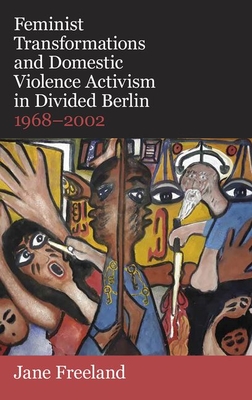
Feminist Transformations and Domestic Violence Activism in Divided Berlin, 1968-2002 by Jane Freeland

In July 2023, the Federal Criminal Police Office in the Federal Republic of Germany (FRG) reported a rise in the number of cases of domestic violence for the fifth consecutive year. While every case is cause for concern, it is difficult to know how to interpret this increase. It is possible that the number of domestic violence incidents really has increased, perhaps because of social stress produced by the COVID-19 pandemic and associated lockdowns. It is also possible to interpret rising numbers as ground for relative optimism, because it may mean that fewer people are suffering in silence and that more believe that the police will help them escape an abusive situation. What remains certain is that there are more episodes of domestic violence in Germany than captured by statistics. The true incidence of domestic violence is inevitably a Dunkelziffer, a known unknown.
Jane Freeland’s book on domestic violence activism in both East and West Berlin offers new tools for thinking critically about how to understand the state’s ability to address the social problem of domestic violence and abuse. In the 1970s, when her narrative begins, the state did not collect statistics on domestic violence. Women living with abusive partners could access virtually no support. There has been immense progress on this front in the past fifty years, and Freeland avowedly begins her investigation into that progress by asking, “from the standpoint of success… [H]ow did feminists steer domestic violence onto the popular and political agenda?” (16). She answers this question through research at a wide range of both state and activist archives alongside interviews with former shelter activists. Reconstructing the trajectory of the shelter movement, Freeland convincingly argues that its success came at a certain cost—namely, the delinking of domestic violence activism from feminism.
The women who organized the first domestic violence shelter in West Berlin consciously distanced their project from the women’s movement. Freeland describes their success as “predicated on this deradicalization and the separation of shelter work from its feminist origins” (87). When these founders sought state support for their shelter, they muted their larger critique of women’s inequality within patriarchal society to instead deliberately present images of vulnerable women and children the state could save. This decision to separate shelter work from feminism helped them to obtain funding from state sources and constituted a defensive strategy to placate hostile forces from wider society. That hostility was mainstream and overt. For example, shortly after the shelter opened in November 1976, BILD sent an undercover reporter who pretended to be a battered woman to the shelter, only to write a cruel article that claimed that the shelter was nothing more than a “hotbed for communism” (54). Even worse, the journalist published the physical address of the shelter, a privacy breach that put the women in the shelter at risk of being tracked down by their abusive partners. Other commentators depicted men as the real victims of the shelter, describing it as part of a larger project to separate children from their fathers and “radicalize” children into communism. One commentator, in an effort to delegitimize the project, mentioned the fact that one of the children staying in the shelter had called a resident of the neighborhood a “capitalist pig” (58).
Other factors pushed activists to downplay their feminism. Based on their own experiences, women knew that domestic violence was a concrete problem, but in the 1970s academic research on the impact of domestic violence was sorely lacking. The shelter activists who had courageously broken the existing silence on this issue then realized that it was more complicated than they had first recognized. They were largely native-born middle-class German women, while their clientele was predominantly working-class women, among them many migrants. They were sometimes surprised that the women who came to them were complex people who might also suffer from addiction, might not want to leave their abusive husbands, or might hit their own children. Most shelter residents needed practical support in the moment and “were not ready, willing or perhaps even able to jump into feminist emancipation” (97).
The activists may have bought into ideas about the perfect victim, and when confronted with the reality they interpreted the intractability of domestic abuse by “drawing on long-standing bourgeois tropes about the working classes” (97). The activists also sometimes “leant into a discourse that demonized racialized men,” especially Turkish men, although a full 30 percent of the foreign women who visited the shelter were in fact being abused by German men—while only 12 percent of the German women were being abused by foreign men (103). With the feminist critique of patriarchy muted, activists consistently ran the risk of finding acceptable scapegoats within West German liberalism rather than showing how liberalism itself remained structured by classism, patriarchy, and racism.
Freeland puts the West Berlin case in conversation with the East and liberalism in conversation with socialism. The official line of the German Democratic Republic (GDR) excoriated domestic violence as a capitalist scourge. The socialist legal system accordingly obscured the continued existence of such abuse when it occurred within marriage. Violence was not always statistically registered as such—when marital abuse took place under the influence of alcohol, it was classified as “alcohol abuse” rather than as “violence.” In the state with the highest rate of beer and spirits consumption in the world at the time, “alcohol abuse” was a common category but one that erased the misogynistic valence of domestic abuse. Although the GDR formalized no-fault divorce in its 1965 Family Law Code, in practice judges only gradually became comfortable with dissolving marriages. In the first half of the 1970s, judges tended to prescribe marital reconciliation, giving abusive men an opportunity to reform through recommitment to socialism, rather than grant women divorces. However, judges became more likely to grant divorces in the second half of the decade, but endemic housing shortages sometimes meant that divorced couples had to continue to share a home, which kept many women in violent homes despite their best efforts at extricating themselves.
In response to such struggles, women in the GDR founded nearly two hundred different women’s groups during the 1980s. The Women’s Tea Parlor in Weimar, which conducted its own research into violence against women, organized a lecture on the topic that it would use to distribute a survey and collect more data. Because feminist politics usually developed out of a broader dissident movement in East Germany, men and women worked together much more frequently than in the West. When women criticized the societal response to domestic violence, “it was the state, not men, which was the target of their critiques” (150). This critique allowed them to theorize sexual consent more broadly than their counterparts in the FRG had done—for example, they recognized that men too could be raped. That recognition was prescient since statistics in 2023 have shown that men are victims of domestic violence in one in every five reported cases, hardly an insubstantial minority.
By showing that what we might understand as “women’s activism” used different interpretive frameworks under state socialism than under liberal democracy, Freeland draws our attention to new ways to narrate social progress in the GDR. For her, it is a mistake to look for “feminism” as a discrete category in the GDR; rather, we should ask how dissidence against the state articulated the interests of women and victims of domestic violence. Freeland shows that while addressing violence helped victims, it also worked to challenge the rule of the Socialist Unity Party. Freeland’s attention to the GDR allows her to offer a provocatively new argument about the consequences of Germany’s unification for women. Historians have often narrated unification as a defeat for women, focusing on the failure of unified Germany to pass abortion reform; in fact, as Freeland demonstrates, unification led to the revitalization of activism against domestic violence. Freeland cautions that this success can be explained by the stubborn persistence of gendered ideals. As she puts it, the vision of women’s rights that thrived in the 1990s was “one that acknowledge[d] a right to bodily integrity only so far as to protect women from male violence, but not one that grant[ed] women a right to self-determination” (191).
Feminist Transformations deserves a wide readership among historians of divided and reunified Germany, as well as among scholars of feminism more broadly. Scholars have shown that gender remained a key marker for differentiating the two German states, but work on how gender relations themselves changed over time has been insufficient. By pairing careful research with bold argumentation, Freeland offers a model for how to write the gender history of divided and unified Germany. She makes it clear that the women’s movement made immense progress in addressing domestic violence but that progress did not come on its own terms.
In this light, the fact that official domestic violence statistics have shown rising numbers for five consecutive years is cause for both cautious optimism and serious concern. The very fact that the state now publishes these statistics is a legacy of the shelter movement that began in the 1970s, a movement that produced new knowledge on the causes and consequences of domestic violence, provided a needed space where women suffering violence could access support, and successfully redefined domestic violence as a matter of public concern. However, because the movement’s success depended on muting a critique of patriarchy, it also arguably led to the dimming of the utopian vision of a society without violence.
Finally, Feminist Transformations helped this reader to better understand how the putative “East German man” continues to be discussed today, over forty years after the fall of that state. It is true that men in the former East represent the most consistent electorate for the new right-wing party Alternative for Germany [AfD]. It is also true that journalists seeking to explain electoral behavior often resort to headlines that tar the “East German man” with the broad brush of an aggressive and excessive masculinity, a masculinity that has left him unable to adapt to his new circumstances. Men in the former West Germany also continue to express authoritarian, racist, and patriarchal values—and have driven their preferred parties closer to the AfD on questions of immigration and gender equality—but when they do so, this expression somehow does not become the defining characteristic of the “Western man” or disqualify him as a potential partner for a deradicalized movement against domestic violence.
The demonization of the “East German man” echoes the earlier demonization of foreign men in the FRG. In both cases, subaltern men become the repository for the traits that feminists wish dominant men would not display. When feminist shelter activists have resorted to scapegoating specific groups of men—or, for that matter, when they have expressed overwhelming disappointment in their working-class and foreign-born female clientele—those tactics have enabled the reconciliation of middle-class native-born men and women by solidifying the racial (white) and class (bourgeois) positions that they share. Freeland’s book shows that while this approach has undeniably benefited women victims of domestic abuse, this improvement has come at the significant cost of a feminism that is internally consistent in its project of liberation for all.
Lauren Stokes is Associate Professor of History at Northwestern University, where she teaches courses about migration history, German history, and the history of gender and sexuality. She is the author of Fear of the Family: Guest Workers and Family Migration in the Federal Republic of Germany (Oxford, 2022).
Feminist Transformations and Domestic Violence Activism in Divided Berlin, 1968-2002
By Jane Freeland
Publisher: Oxford University Press
Hardcover / 240 pages / 2022
ISBN: 9780197267110 (available as an open-access title)
Published on November 21, 2023.




